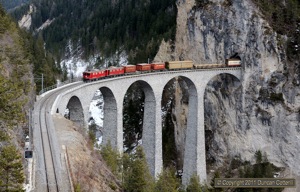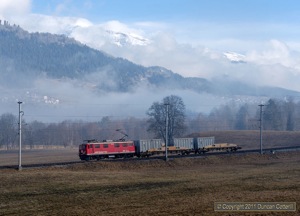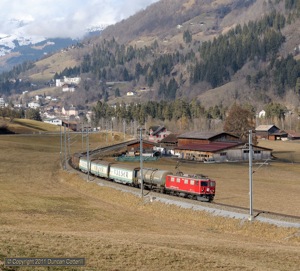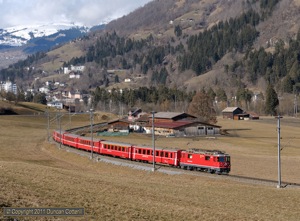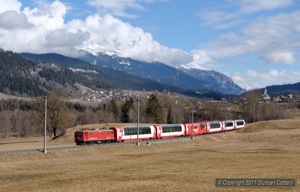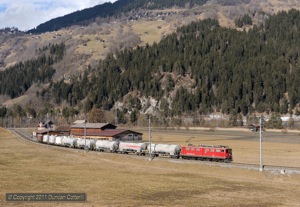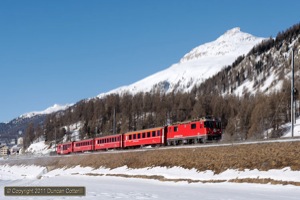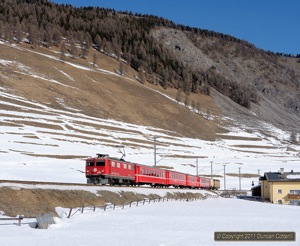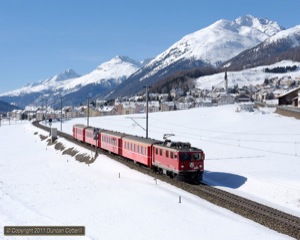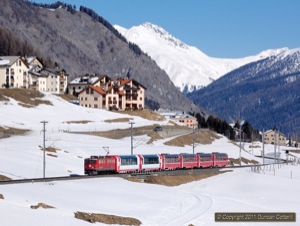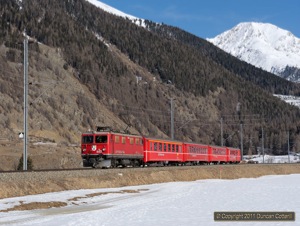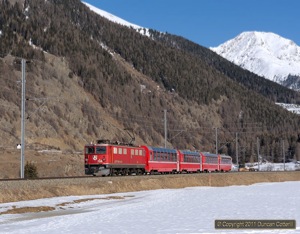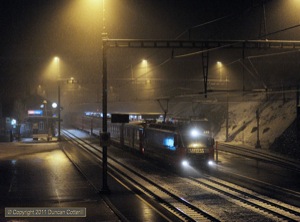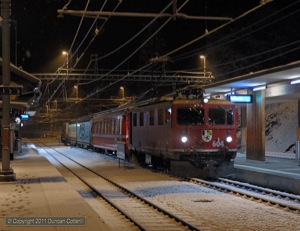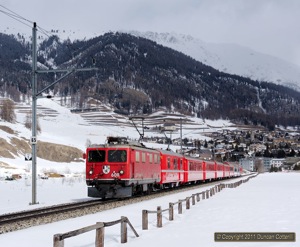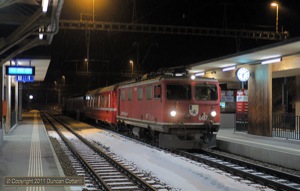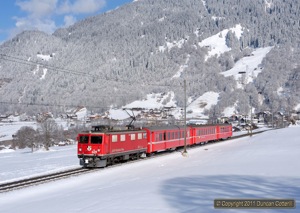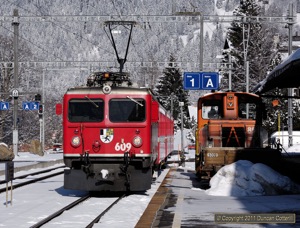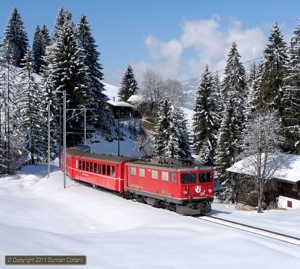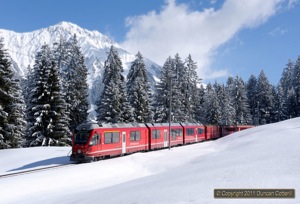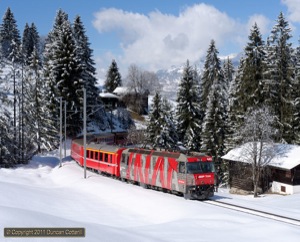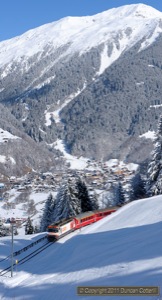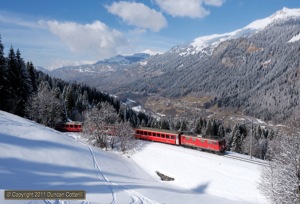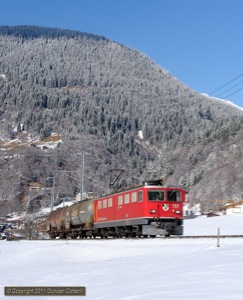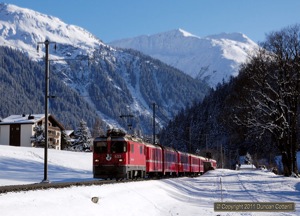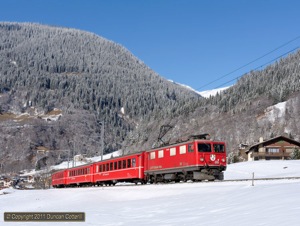Farewell to the RhB Ge4/4i
16 - 23 February 2011
Report by Duncan Cotterill
Introduction
This report covers an eight day trip to the Rhätischebahn from Wednesday 16 to Wednesday 23 February 2011.
The Rhätischebahn operates an extensive 1000mm gauge electrified system in the south-east Swiss canton of Graubünden. The area is very popular with winter sports fans and the railway is at its busiest from late December to early March. The RhB serves a number of resorts including Klosters, Davos, St. Moritz and Pontresina and operates a number of additional services to cater for skiers, snowboarders and sledgers. They also tend to use the oldest and most interesting locos so, inadvertently, cater for railway enthusiasts as well!
The railway is currently in the middle of a significant modernization programme that will see the replacement of several old classes with modern EMUs. There are very few changes to the train service since last year but some significant changes to the motive power booked to work a number of services.
This page summarises what was seen. For train by train details with loco numbers etc, go to the Day by Day pages.
Changing Times
The first of the new Stadler “Allegra” ABe8/12 units entered service on the Berninabahn in January 2010 and by the autumn there were enough of the new units in traffic to allow the withdrawal of all the 1960s vintage ABe4/4ii motor coaches. Until October 2010, the main system was largely unaffected by the changes but since then the new units have progressively taken over three diagrams on the Landquart – Davos – Filisur circuit and a fourth covering the Chur – Arosa line during the week and the Chur – Tirano Bernina Expresses at the weekends.
The new units have displaced four locos, three Ge4/4iis and a Ge4/4iii. The Ge4/4iis have been used to replace 1947 vintage Ge4/4is on two Engadin push-pull diagrams and the Chur based turn that handles peak hour trains during the week and operates additional Bergün – Preda Schlittelzüge at weekends. The Ge4/4iii has effectively become spare reducing the chances of other classes appearing on Landquart – Davos or Chur – St. Moritz trains.
Class Ge6/6ii now has no diagrammed passenger work. Six locos are booked to work freight on Mondays to Fridays, one works on Saturdays and none on Sundays.
The nine remaining Ge4/4is are still booked to cover four passenger turns daily and one mixed passenger/freight turn and two freight turns on Monday to Friday. The most prestigious working is the Glacier Express, which is diagrammed for a Ge4/4i from Chur to Disentis and back every day. Two more locos cover the hourly Klosters Dorf – Davos Sportzüge and third works the hourly Bergün – Preda Schlittelzüge. The Sportzüge and Schlittelzüge are winter sports trains that only run until 6 March.
The mixed passenger/freight turn actually involves a mixed train, 4109, conveniently timed to leave Chur at 04:58 for Samedan. After a few hours rest the loco works RE1125 from Samedan to St. Moritz (while the train engine takes the Bernina Express coaches to Pontresina) then returns north with early afternoon freight 5152 from Samedan to Landquart. At weekends the Bernina express runs as a separate train, hauled by a new EMU, so there is no need for an additional loco to work RE1125 to St. Moritz.
One of the freight diagrams involves morning and evening trips from Lanquart to Ilanz and back and an afternoon trip from Landquart to Jenaz and back. A second diagram covers a few short trips around Chur.
The spring diagrams indicate that the remaining Ge4/4is will lose all their booked work at the end of the winter sports season on 6 March and it’s expected that they will be withdrawn by the end of May, almost 64 years after the first of the class entered service.
Elsewhere on the main system the only significant change concerns the additional trains that run between Landquart and St. Moritz via the Vereina Tunnel. This winter there are two trains each way daily except on Saturdays when there are three. Ge4/4iis are booked to work all these services except on a Saturday when one working is booked for a Be4/4 motor coach and Chur area suburban set. The extra Saturday train replaces an additional service that ran from Chur to St. Moritz via the Albula on Saturdays last year.
Well, that was the theory, read on to find what happened in practice.
Class by Class Roundup
Ge4/4i
My worst fears were that a surplus of new units would cascade through the roster and leave the Ge4/4is with little work to do. That certainly was not the case and the Ge4/4is covered most of their diagrammed trains on most days.
The principal exceptions were duty 403, covering a few freight trips in the Chur area, which never ran at all, and duty 401, which covered the morning and evening freights to Ilanz, as diagrammed, but not the afternoon trip to Jenaz.
On the passenger side, one of the Klosters – Davos shuttles was covered by a Be4/4 vice Ge4/4i on Saturday and part of Sunday. However the losses were outweighed by the gains with 609 covering RE1327 and RE1342 on the Landquart – St. Moritz route on Saturday. On Sunday 607 and 603 double-headed RE1327 south, returning single-headed on RE1350 and RE1358 respectively. The highlight for me was 602 spending four days in the Engadin working primarily on the Pontresina – Scuol-Tarasp route where Ge4/4is had been regular performers until the December timetable change.
Of the nine surviving Ge4/4is, eight were seen in action. Only 606, which was spare at Samedan the whole week, wasn’t seen.
Ge4/4ii
Two locos (620 & 623) were in works with a third (621) going in while I was there. This left things a bit tight, particularly at the weekend when a number of strengthened Chur – Arosa and Landquart – Scuol-Tarasp workings required double heading. As a result there were a number of substitutions, as mentioned elsewhere in the report.
While it’s very easy to find Ge4/4iis working, it’s more difficult to find examples worth photographing as six locos now carry non-standard liveries, five of which are hideous. Only 619 in “Bernina 100” livery has any merit at all.
Ge4/4iii
Every single Chur – St. Moritz train was Ge4/4iii hauled, a contrast to previous trips when Ge4/4ii or Ge6/6ii were either diagrammed to work a few trains or substituted on a relatively frequent basis.
On Saturday and Sunday an ABe8/12 substituted for one of the two Ge4/4iiis on the Landquart – Davos route. The loco released was then used to work Scuol-Tarasp – Disentis trains on Saturday, releasing a Ge4/4ii for other duties. Also on Saturday there were four Ge4/4iiis allocated to car-shuttle duties in the Vereina tunnel instead of the usual three. On the Sunday the Vereina returned to normal but the additional unit continued to work Davos trains resulting in two Ge4/4iii being spare. By the end of my trip 651 had gone into works.
Ge6/6ii
These locos worked their booked freights throughout my visit but did very little else. They used to be favourites to substitute for Ge4/4ii and Ge4/4iii on passengers on the Chur – St. Moritz and Disentis – Scuol routes but there was only one substitution during my visit. On Saturday 704 worked RE1335 from Landquart to St. Moritz and RE1350 back vice a Ge4/4ii.
Six of the seven locos worked consistently during my visit, rotating through the six weekday diagrams. The seventh loco, 701, was either under repair or spare for the duration.
Gem4/4
Neither of the two Gem4/4s worked a passenger train during my visit. With most of the new units in service and several ABe4/4iii motor coaches in reserve, it’s difficult to envisage why they would be used. 801 spent the whole period under repair at Poschiavo. 802 was on snowplough duty but as there wasn’t a lot of snow, it didn’t see much use.
Be4/4
The Be4/4 motor coaches worked their booked trains on the Chur – Thusis and Schiers – Rhäzüns routes throughout my visit. On Saturday 516 covered one of the Klosters – Davos turns, releasing the Ge4/4i and push-pull set to work one of the Landquart – St. Moritz trains. 512 was also pressed into service on the same route on Sunday when one of the Ge4/4i worked push-pull sets developed a problem.
ABe4/4ii
These 1960s vintage Berninabahn motor coaches were withdrawn in the autumn following the introduction of new Allegra EMUs on the St. Moritz – Tirano route. Many have already been scrapped but 48, one of three earmarked for departmental use, was seen being dragged from Pontresina to Landquart on the Monday.
ABe4/4iii
While the six ABe4/4iii motor coaches remain in service, they definitely play second fiddle to the new units on the Bernina. Two pairs of ABe4/4iiis are diagrammed to work alongside four ABe8/12s but on most days there was an additional ABe8/12 in use and only one pair of motor coaches. To make matters worse, all of the ABe4/4iiis are now in stupid liveries.
ABe8/12
The new units are now having a real impact on RhB services, operating the majority of services on the Bernina and Landquart – Davos – Filisur routes and now starting to appear on the Arosa line as well. Out of 15 units on order, 13 are now on the system with up to 11 in service at any one time. The winter diagrams call for 8 units (4 Bernina, 3 Landquart – Davos and 1 Arosa) but on most days there were 9 in use with an additional unit on the Bernina. Two more units were in service on the Saturday and Sunday with an additional unit on the Davos route and another on the Arosa line. 12 units are required to operate the service from 7 March, when the Arosa line goes over to the new units.
As units go they’re rather unusual in packing over 3000 horsepower, only marginally less than the Ge4/4iiis, and the railway uses them to haul conventional coaches in the same way as a locomotive. At least one train seen on the Davos line had 10 coaches behind the unit. The diagrams are constructed so that the Allegras rotate through workings on the main system and the Bernina with early morning mixed 4309 and late evening freight 5378 used to transfer units from Landquart to the Bernina and back. Although the diagrams show the same unit working the weekend Bernina Express from Chur to Tirano and back, in practice different units were used in each direction.
Photography
This trip was unashamedly aimed at maximizing the number of Ge4/4i shots. Of course, I took pictures of other classes but the Ge4/4is had absolute priority and I would happily miss several shots for a single good Ge4/4i picture.
With no shortage of Ge4/4is to photograph and information on workings freely available, the biggest potential problem was the weather. The trip started well enough with a few shots on the first afternoon at Landwasser Viaduct, including 607 and 608 double-heading freight 5152, then a good morning at Ilanz with 608 on freight and 604 on the Glacier Express. Day three was a write off but day four, the Saturday, had wall to wall sunshine until just after I’d taken my last shot. I spent the whole day in the Engadin where 602 was working Pontresina – Scuol-Tarasp trains and 609 and 704 put in appearances on Landquart – St. Moritz workings.
So far, so good. I’d got quite a number of the shots I wanted but not my top priority pictures around Klosters and Cavadürli. Days five and six were write offs with precious little sun and certainly no shots. Day seven was only a little better, but not much, and I was extremely lucky to get a shot of 608 in sun on RE1125 near Samedan.
That left just one day, Wednesday, to get the pictures I wanted most. Klosters was a convenient place to dump my luggage for the day and the forecast was quite good. For once, reality was even better than the prediction with deep blue skies and the few clouds keeping well out of the way. There was fresh snow on the ground and the trees were coated with white. Perfect photographic conditions in other words. 609 and 610 performed faultlessly on the Klosters – Davos shuttles, providing plenty of opportunities to bag the required shots. It had been a difficult trip but at least it ended on a real high.
Although this was my eighth trip to the RhB, I was surprised at the number of new photo positions I found, some at places I thought there might be a shot and others that I’d never considered before. It was also noticeable how much more light there was (on sunny days at least) compared with December or early January. The shadows cleared some locations a full hour earlier than on my previous winter trips and several positions that had been impossible in mid-winter were well lit for several hours. On the other hand the snow cover was generally very patchy but that was probably due to the lack of snowfall for several weeks rather than the fact it was February. It did make it much easier to get around though with less time spent wading through knee deep snow.
The new units may not be to everyone’s taste but at least they’re painted red and they do actually photograph quite well, particularly with a long string of coaches coupled behind. Given the choice of photographing a red unit or a loco in one of the uglier advertising liveries, I’d have to go for the unit every time.
Logistics
I flew from Heathrow to Zürich with Swiss then travelled around Switzerland by train, using ordinary tickets for the journeys from Zürich to Graubünden and back. A Monats BüGA ticket was to get around on the Rhätischebahn. Although it was valid for a whole month, just using it for 8 days still provided better value than other rover tickets. My base on the RhB was the Hotel Grischuna at Filisur, conveniently situated at the south end of platform 1.
The Future
When the last of the 15 Allegras arrives in a few months the RhB will be able to cover the entire service on the Bernina, Landquart – Davos – Filisur and Chur – Arosa routes with units for much of the year but with no spares. During the summer season, additional Bernina Express workings mean that other classes will need to be used on a few services. It’s not clear yet where this will be or which classes will be used.
An additional 5 4-car units classified ABe4/14 or ABe4/16 (depending on which source you believe - ABe4/14 implies partial articulation) will follow the 15 ABe8/12s. These are lower powered 11kV only units for the Chur and Landquart area suburban services and will replace the 6 Be4/4 motor coaches and their trailers from spring 2012. The Be4/4 date from the early 1970s and were refitted with new electrical equipment in the mid 1990s, so they’re fairly new by RhB standards and it would be a surprise if they went for scrap. If they aren’t scrapped it will be interesting to see where they are used.
Four class Gm4/4 diesel locos for departmental work are also on order for delivery in 2012. They are powerful machines rated at 1800kW and are expected to be used on snowplough duty on the Bernina among other jobs, replacing the Gem4/4s which will, no doubt, be withdrawn.
In December 2010 the RhB and Stadler announced an order for seven additional 6-car trainsets for the Albula line to be delivered in 2013. From the press release it appeared that these trains would be EMUs, although it doesn’t say so explicitly. I’ve now been told that they will be permanently coupled loco hauled rakes and not units.
The ABe4/4iis have finished and the Ge4/4is will be gone soon but that’s only the start. It can’t be too long before the RhB is all modern units and a few locos in unattractive liveries. Get what’s left while you can.
Postscript
The Ge4/4is did disappear at the end of the Winter timetable but it wasn’t long before a few reappeared, covering light duties whenever motive power was in short supply. Three were still in traffic until the end of the following year’s Winter timetable as you can read here.
